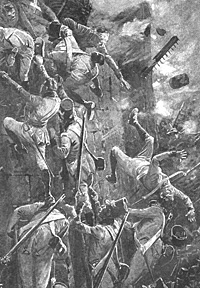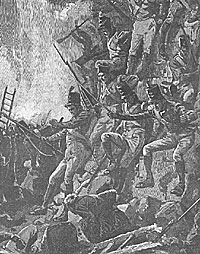This stereotype is misleading,
however, since Napoleon was actually very
interested in fortresses and siegecraft. As a
gunner and the victor of Toulon, after all,
he was fully conversant with the scientific
aspects. In his 'classic' campaigns of
invasion such as Austerlitz or Jena,
moreover, he made it a rule never to move
anywhere without having a strong
fortification at least once in every four
days' march along his line of
communication (or Route de l'Armee.
These fortifications had many roles: as
centres to control conquered areas or to
collect supplies and convoys and defend
them against enemy raids. They would also
be rallying points for reinforcements
moving up to the front, who would
themselves normally provide the garrisons
without taking soldiers directly out of the
front line. And if the worst should happen,
these forts would provide rallying points
and depots for Napoleon's retreating army
if it were defeated.
In the case of Wellington, however,
the general impression is that he was still
an eighteenth century type of commander --
taking everything very slowly and
carefully, and placing great importance on
siege warfare - but actually this too is very
far from the truth. Wellington was in reality
a very mobile and aggressive commander,
and often a gambler (as Michael Glover,
among others, has ably argued in his
numerous Peninsular histories [1]
), Wellington was excellent at seizing
fleeting opportunities to make an attack,
which was an art he had learned in his
Indian battles at Assaye and Argaum, and
then carried forward to Oporto (1809),
Salamanca (1812) and Vittoria (1813).
It was only in the period between
Oporto and Salamanca -- or more
accurately from Talavera, which was a
failed offensive that followed soon after
Oporto - that he was forced to adopt a
more defensive posture for the security of
Portugal, which has been called
Wellington's 'Cautious System'. It is this
period of almost three years in 1809-11
which has branded him as a defensive
general in many people's eyes.
In fact, however, even during this
'cautious' phase he made several attacks on
the French fortresses covering the exits
from Portugal -- usually Badajoz -- but it
was largely because he failed to win these
sieges before 1812 that he was unable to
burst out into the Spanish plains for more
adventurous manoeuvres.
The trouble was that Wellington
was really not much good at siege warfare.
It was perhaps his greatest weakness as a
commander. Just as he had learned the
power of a sudden offensive in the field, in India, he had also found in that theatre -- at
the sieges of Dummul, Arrakerry,
Armednuggur and Gawilghur -- that any
Indian fortress could be carried very
quickly by a sudden storming.
Unfortunately the same was not
true against the scientific French, and these
'colonial style' assaults often bounced off
carefully-prepared defences manned by
determined troops with knowledgeable commanders.
In the Peninsula there were always
grave difficulties of logistics and these
became acute whenever it was necessary to
collect the vast mass of materiel, artillery
and ammunition required for a siege. The
navy might quibble over the release of its
guns for land service; the roads would be
exceptionally tested by the exceptional
demands of the siege train, and considerable
powers of foresight would be required to
predict the probable need for such items as
shovels, gabions, scaling ladders or building
timber. There was also a sorry shortage
of trained engineers, with the Corps of
Sappers and Miners being created only
towards the end of the war, after the Royal
Military Artificers had been shown to be
inadequate in both numbers and skills
during the important earlier sieges. Engineer
officers had a distressing habit of being hit
by enemy fire at the very start of digging
operations or, in the case of the great
Badajoz storming, at the start of the assault
they were intended to direct throughout its
duration.
[2]
In these circumstances Wellington
often found that his strategic needs were
too pressing to wait for the realistic speed
of these siege operations, so he would be
tempted to insist on dangerous haste. This
in turn implied a willingness to expend the
lives of his troops in the interests of a
quick success, and there were some horrible
scenes of carnage in the ditches at the base
of ill-prepared breaches.
Against this, it may perhaps be
argued that Wellington made constant
subconscious calculations about just how
many lives he could afford to gamble, in
order to win an important fortress in good
time. No one can deny that he was a
numerate general, just as he was certainly
an experienced one.
Thus although he wept openly at
the horrific scale of casualties in the
eventual capture of Badajoz, he surely also
realised in that moment that the plains of
Leon lay open to him as a direct result of
the sacrifice. The capture of Badajoz
opened the road to Madrid for the first
time since the strategic defeat of the
Talavera campaign almost three years
earlier, and although the victory of
Salamanca would cost a further 5.200 allied
casualties, it surely more than made up for
the relative balance of losses as between
the allies and the French.
If it is true that Wellington really
did base his gambles in siegecraft upon
some basis of subconsciously-perceived
'vital statistics', then it would surely be
interesting to find out just what those
statistics might have been.
In an attempt to find out, I looked
up the classic Journal of Sieges in Spain by
Sir John T Jones.' Within its pages there
are details of all the British sieges between
1811 and 1814, although not quite all of
them were Wellington's. Jones' selection
includes Bergen op Zoom in the
Netherlands, one in southern Italy and a
couple on Walcheren island, as well as the
French attack on Tarifa, near Gibraltar,
which was the only Peninsular siege where
the British (as opposed to their Spanish
allies) were the defenders. However, I don't
think it is illegitimate to include these 'non
Wellington' cases, since their general
conditions seem to have been very
consistent with what Wellington himself
was doing in his attacks on fortresses.
From these statistics we can see
just how attractive it must have been to lay
siege to a fortress, insofar as almost 40% of
the forts attacked were pretty small and
weak, and of these almost 80% surrendered
before they were stormed at all.(See Table
1) Of the remaining forts that were 'big', a
third was attacked by an army which seems
to have been of adequate strength and fully
prepared.' Apart from their superior
artillery and engineer assets, these could
normally mount three or four assault
columns in the final storming, which was
enough to swamp the defences in 80% of
cases.
The real problem comes when we
turn to the 9 cases when big fortresses were
attacked by small armies. Wellington is
shown in his worst light whenever this
happened, and in the first attempt against
Badajoz in May 1811 he was so slow to
develop a convincing attack that Soult's
relieving army was able to arrive before a
storming could even be mounted. At
Pampluna in July 1813 Wellington decided
on a blockade rather than any sort of siege,
although he betrayed his frustration by
issuing the most blood-curdling instructions
that his Spanish allies should hang the
entire garrison if they should ever manage
to catch 'em.
Soon after this Wellington's
frustration came to boiling point when
Graham's ill-prepared first effort to storm
San Sebastian ended ignominiously, just at
the moment when Marshal Soult (once
again!) was dealing a shrewd surprise blow
across the inland mountains.
Overall, only in 22% of the 'Small
Army vs Big Fort' attacks was the fort
finally captured, which is an almost
diametrically opposite to the result from
the 80% success of 'Adequate Army vs Big
Fort' attacks. The need for numerous attack
fronts is certainly confirmed (See Table 2)
when we analyse the stormings in terms of
the number of assault columns used in each
case.
Thus we only have 2 examples of
stormings against small forts but, it is
notable that one (at Almaraz) was
successful when it used 3 columns -
thereby splitting the defender's attention
and fire while the other (at Tarifa) failed in
a single column. The same is true with the
'big forts attacked by adequate armies',
where 80% of the assaults were in 3 or 4
columns - although admittedly the one
attack in a single column (at San Sebastian)
was also a success. Equally the generally unsuccessful cases of 'big
forts attacked by small armies' were all in
only one or two columns, and showed a
poor record of success.
Let us consider the success of each
individual column .(See Table 3: Success of
each Column): The very difficult nature of
actual stormings is shown by the fact that
over half of them ended in total failure, and
less than 30% of the assaults were
'completely' successful against big forts.
Even in multiple assaults which together
led to the capture of the fort, the majority
of the columns might fail and even, as
'Feints', may have been excpected to fail.
Finally, let's look at the casualties
suffered within each of the storming
columns. Contrary to our expectations, we
find that the least successful assaults
tended to suffer relatively light casualties,
whereas the more effective attacks were
often by far the bloodiest. Perhaps this
shows that a failed attack tended to be over
quickly although in several cases, such as
the second siege of Badajoz, the storming
party stayed in the ditch for a full hour,
trying to find a viable escalade, before it
retired. It was certainly the most
determined troops who pressed on into
danger and paid the price, and particularly
in the case of 'partial' successes, which
tended to be bloodier than 'complete' ones.
Storming Through the Peninsula
 Siege warfare is a rather
neglected part of Napoleonic studies, since
it is generally assumed that the great
Emperor had 'revolutionised' the art of war
to the extent that sieges were no longer
important. In 1800 he had scornfully by-passed Fort Bard, on the Italian frontier, in
order to strike deep into the heart of the
country and fight a decisive battle at
Marengo. If the campaign had been fought
by some of his eighteenth century
predecessors, it would doubtless have
settled down into a long siege on the
frontier, and stayed there.
Siege warfare is a rather
neglected part of Napoleonic studies, since
it is generally assumed that the great
Emperor had 'revolutionised' the art of war
to the extent that sieges were no longer
important. In 1800 he had scornfully by-passed Fort Bard, on the Italian frontier, in
order to strike deep into the heart of the
country and fight a decisive battle at
Marengo. If the campaign had been fought
by some of his eighteenth century
predecessors, it would doubtless have
settled down into a long siege on the
frontier, and stayed there.
The Role of Siege in Napoleonic Warfare The MYTH The REALITY Napoleon's deep invasions removed the need for fortresses. Napoleon always cemented his L of C with fortresses. The 'mobile' French didn't need to run sieges in either attack or defence.
They often did run them, and were very good at them. The British had a "plodding 18th century-style" army, ie were good at sieges.
Wellington, at least, was poor in siege warfare (= more like the French image!).
The French used the column but the British used the line (in tactics). Wellington used big columns repeatedly in his sieges, but the French engineered in lines.  The third Badajoz siege in April 1812,
in particular, is notorious less for the very
heavy toll of 1,300 casualties lost during its
preliminary engineering phase than for the
3,700 casualties suffered in the final
storming. This total of 5,000 men -- the
equivalent to an entire Division -- is the
type of loss to be expected in a major
battle; and after Talavera it was in fact the
second longest butcher's bill that
Wellington had ever suffered up to that
point. [3]
The third Badajoz siege in April 1812,
in particular, is notorious less for the very
heavy toll of 1,300 casualties lost during its
preliminary engineering phase than for the
3,700 casualties suffered in the final
storming. This total of 5,000 men -- the
equivalent to an entire Division -- is the
type of loss to be expected in a major
battle; and after Talavera it was in fact the
second longest butcher's bill that
Wellington had ever suffered up to that
point. [3]
 Hence the British can scarcely be
faulted in the cases of attacks against small
forts, or against big forts attacked by
adequate armies - i.e. slightly more than
a half of the total - and in fact the only 'big'
fortress which ultimately survived attack
by what I have called an 'adequate' army
was Bergen op Zoom (ie Not one of
Wellington's sieges); whereas the only
'small' fortress which survived attack was
Tarifa (when it was the French attacking a
British garrison). So far so good the
casualties in these assaults may have been
horrific, and far more than Vauban would
have been happy to accept - but the final
strategic success represented by the
capture of the fort surely goes a long way
to absolve Wellington of serious blame.
Hence the British can scarcely be
faulted in the cases of attacks against small
forts, or against big forts attacked by
adequate armies - i.e. slightly more than
a half of the total - and in fact the only 'big'
fortress which ultimately survived attack
by what I have called an 'adequate' army
was Bergen op Zoom (ie Not one of
Wellington's sieges); whereas the only
'small' fortress which survived attack was
Tarifa (when it was the French attacking a
British garrison). So far so good the
casualties in these assaults may have been
horrific, and far more than Vauban would
have been happy to accept - but the final
strategic success represented by the
capture of the fort surely goes a long way
to absolve Wellington of serious blame.
NOTES
[1] e.g. his
Wellington as a Military Commander
(Batsford, London 1968).
[2] The
Siege of Ciudad Rodrigo, and the three sieges of
Badajoz, are covered in Oman's History of the
Peninsular War, Vol IV, pp.247, 315, 404.,,
and Vol V, pp. 157, 244.
[3] See the
table of losses in all Wellington's battles
presented in the Appendix of Paddy Griffith, ed.,
Wellington - Commander (Bird and the
V&A, London 1984).
[4] First
published 1813, but soon updated to
include the end of the war in 1814.
My own analysis of the statistics that can be
extracted from Jones first appeared in Empires,
Eagles & Lions magazine #97, Nov-Dec
1986, and the present article is based largely on that.
[5] I have
found no scientific definition for what constitutes
an 'adequate' army for the attack of a large fortress,
since any army with a strength over around
30,000 men will probably have enough troops.
More important for the army's adequacy must be
less easily-quantifiable aspects such as adequate
engineer and artillery resources. I have been able
to assess these only an a subjective basis,
although I am reassured to find that my
assessment generally seems consistent with the
number of assault columns finally used.
Siege Operations in the Napoleonic Wars
Table 1: Small Forts are Easy Prey and Big Forts Can Be Taken
Table 2: Number of Columns in Each Attack
Table 3: Success of Each Column Against a Big Fort
Peninsula Storming The Game
Back to Napoleonic Notes and Queries # 14 Table of Contents
Back to Age of Napoleon List of Issues
Back to MagWeb Master List of Magazines
© Copyright 1994 by Partizan Press.
This article appears in MagWeb (Magazine Web) on the Internet World Wide Web.
Other articles from military history and related magazines are available at http://www.magweb.com